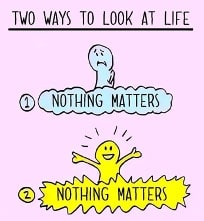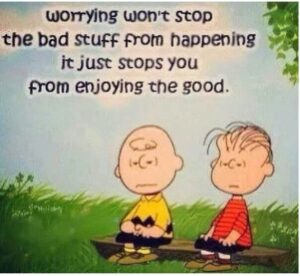Leaving out complicating factors like significant trauma, or medical diagnoses, here are my thoughts on anxiety. A couple paraphrased quotes to get you on the right page when it comes to managing anxiety: “spend 95% of your time understanding the problem, and you’ll only need 5% of the time to solve it”, and, “you cannot solve your problems with the same thinking you used when you created them”. And a quick point about anxiety vs stress: what’s the difference? Well, not the point of this blog, but it’s important to know that they’re like a Ven diagram, with lots of overlap and some distinct differences. Now, let’s do this question-and-answer style.
What is Anxiety?
It’s a physiological response to a threat (perceived or real). Insert the usual anxiety provoking stimuli here; speeches, meeting the in-laws, getting pulled over by the police, being chased by the proverbial sabretooth tiger. It’s a threat to your safety, pride, reputation, finances, heart, or loved ones, etc. It activates a part of your central nervous system, the fight/flight/freeze response, to varying degrees. It’s your Spidey sense preparing the body to address whatever the threat is. Although like my earlier issues of Spiderman, your way of handling anxiety may either help it, or, make it worse. Anxiety will pour poison in your ear and call it honey. It is fantastic at infecting our rational thinking and making us believe the irrational and the unlikely.
Where is it?
It resides in 2 places, our thoughts, and our body (sensations). This is a complicated task to spell out in a couple paragraphs, but here we go.
Thoughts: it’s what we focus on, how we perceive the world around us, the perspective we take on a situation, our prediction about how we will handle something or how something will go, and how we interpret events in our life. Whew. Simply put, it’s your style of thinking that’s important here.
Body: as noted above, fight/flight/freeze is when it’s big anxiety, however low key, chronic anxiety is more sneaky. It creates the tension in muscle groups, the gastro “butterflies” and knots in our stomach, the heaviness on our chest, the difficulty in breathing, the light-headed and dizziness, the difficulty initiating or maintaining sleep, and the racing or difficult to focus thoughts.
Why do I have it?
I’d love to geek out and go into the Darwinian theories on the evolutionary origins of anxiety, but I’d just be tooting my own horn. What’s important here is that anxiety serves a purpose. It’s helped steer us away from possible future “danger”, or it’s helped us face “danger” when confronted. A necessary and useful purpose. It’s a part of our greater whole. Again, more on this later.
When is it too much?
Basically, if you find the negative impact of anxiety is getting out of hand, impacting you significantly in one or multiple areas, and it’s preventing you from working towards your goals, then it’s too much.
Who can help me?
Since anxiety is a mind-body impact, various healthcare providers can help. The 1st line of attack would be therapists and physicians, while important additions are naturopaths, RMTs, chiropractors, and acupuncturists to name a few.
How do I decrease anxiety?
This part really requires the individual assessment and work of a therapist to be unique for you. That being said, here are some broad sweeps for addressing anxiety.
As stated above, anxiety is a part of you. You can’t cut it off. Start by generating acceptance & self-compassion for your anxiety, considering gratefully how it’s tried to help keep you safe from threats. Intention over impact here. Not an easy opening task, eh? The alternative is continued/increased suffering via anger at a part of yourself.
Next, remember that anxiety activates your body. There’s a Feedback Loop that occurs as anxious thoughts produce body tension, then body tension serves as evidence for anxious thoughts, so try interrupting this loop by figuring out what calms you down. We’re not talking going from an 8 to a 2, just down to a 7 or 6, any little bit helps.
Next, when anxiety is creeping up, practice metacognition or mindfulness of thoughts. A fancy way of saying “think about your thinking”. Chances are, your thoughts are likely distorted. Get to know the common Cognitive Distortions. Easy google search. When anxiety is running your show, you’re likely getting caught up in one or multiple of these.
Now let’s put it together. When anxiety is knocking at your door, your self-compassion will be the gentle door opening, your mindfulness will be the magnifying glass in which you see if you’re making cognitive distortions, and the slogan of “is this helpful or hindering” will be your evaluative tool for what kind action you need to take next. The 3 C’s of catch, challenge, and change is the overall sequence you’ll need to work through during anxious situations, but also, can be a proactive method for preparing for future anxious situations.
This brief blog is certainly not a replacement for talking to a doctor or therapist about difficult to manage anxiety. Reach out to us for a free meet and greet and we’ll discuss your desire to address anxiety related struggles in your life.
By: Jason Townsley, MSW, RSW


